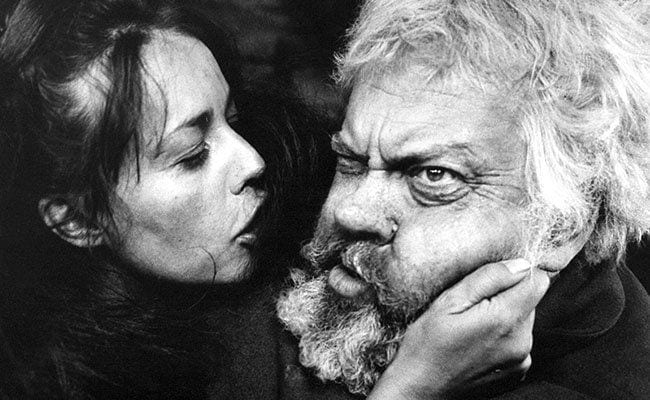
Criterion has done film buffs a favor (again) with this double shot of hard-to-find Orson Welles films of the ‘60s, both co-starring himself and Jeanne Moreau.
Chimes at Midnight (1965) manufactures a new Shakespeare play by combining scenes from five plays into the story of rollicking scoundrel John Falstaff (Welles) and his carousing friendship with the dissolute Prince Hal (Keith Baxter), the future Henry V. Moreau appears as Falstaff’s girlfriend, while Margaret Rutherford is Mistress Quickly. John Gielgud is the stern and disappointed Henry IV. It’s a rich, human story, anchored by Shakespeare’s language and buoyed by joyous performances. Welles’ portrayal of the massive ne’er-do-well climaxes in a great emotional moment that, according to the Welles biographers interviewed in the extras, resonates with his own feelings about his father.
It’s never been possible to see or hear this movie in anything resembling the astounding clarity of this digital restoration. For one thing, the post-dubbed soundtrack has never quite been in sync. To those of us who’ve managed to catch one of the rare video releases of this much-wrangled item, this Blu-ray is a revelation that justifies the hype of those who proclaimed it a masterpiece. Every shot is beautifully composed, often with a whirling, intimate camera that feels inspired by the Russian approach to historical cinema. Most innovatively, Welles uses the off-and-on, catch-as-catch-can shooting style of his late period to discover the wonders of editing. He applies his lessons to a jaw-dropping set piece: one of the first battle scenes in cinema to be brutal, muddy, and barbaric.
James Naremore’s commentary is mostly Shakespeare blow-by-blow, while interviews with Simon Callow and Joseph McBride add personal background. Also interviewed are Keith Baxter and Welles’ daughter Beatrice, who played the nine-year-old page boy and discusses her fabulous childhood.

Orson Welles in The Immortal Story (1968)
Both Baxter and Norman Eshley, who are interviewed on Criterion’s The Immortal Story (1968), report having a temporary father/son kind of relationship with Welles in which they were welcomed into the inner sanctum. Eshley was cast to play the young sailor recruited by a rapacious old capitalist (Welles) to spend the night with his pretend-wife (Moreau) in a delicate tale about make-believe and storytelling spun by Isak Dinesen (aka Karen Blixen) in one of her urbane erudite fables.
That one-hour film was produced for French TV by Moreau’s agent, Micheline Rozan. Welles’ first film in color, it was shot as a soft-focus tone-poem by young French New Wave photographer Willy Kurant and scored entirely with bits and pieces of Erik Satie’s piano music long before scoring with pre-existing classical music became a cliché. It took Welles a year to edit the picture, as Welles scholar Francois Thomas says in an extra. It was shown on French TV with a rather abstract documentary, included here, that features Welles interviews and comments by Moreau. Of most fun is the chatty, informed commentary by scholar Adrian Martin, rescued from a previous DVD.
Two versions of the film are included, because the 50-minute French version runs about seven minutes shorter than the English version. The English version includes more dialogue between the old man and the sailor and more morning-after talk between the sailor and the woman. It includes a few alternate takes and the use of Welles’ voice (dubbed by Philippe Noiret in French). An interesting difference is that Welles also narrates the opening of the English version, pausing to allow comments from local men on the street, one of whom is Fernando Rey (the Earl of Worcester in Chimes at Midnight).
The French narrator incorporates the comments from the figures on screen, so we have the neat visual trick of hearing the narrator suddenly match the lips of the men instead of hearing them speak. (The same gag is used in Welles’ 1958 TV pilot The Fountain of Youth.) Then Welles’ character is introduced in a tableau of reflecting mirrors similar to a famous shot in Citizen Kane (1941), reminding us that the young actor who played that old man is now really that old; it also, of course, reminds us of the multiple Orsons in the climax of The Lady from Shanghai (1947).
Both films are the epitome of elegant, sophisticated, civilized cinema that uses literary sources as a respectful base for visual and aural bravura. In short, this is Art, and we must shake our heads at the sabotaging distribution practices and often clueless critical reception that have conspired to keep people from seeing these films for decades. Well, they’re here now. Dare we wonder if The Trial (1962) can be far behind?

